
Head trips - philosophy and psychology
The skydive experience transcends normal existence. Freefall presents us with the opportunity to enter a joyful condition of flow. We skydive intricate dances on wings made of earth-pushed wind. The music of our sky dance is the rhythm of its flow.
The sky dance philosophy is love of wisdom or knowledge of the art of freefall relative work. The sky dance psychology is the mental process indicated to achieve and retain the sky dance philosophy.
The following articles are some head trips relating to the understanding of the above. Here are different approaches to relating to our thing of doing what we love to do: skydive.
Freefall RW requires other people to relate to.
Smile at the next
toad who goofs.
The Art of "Serious" Fun jumping, or Avoiding DZ Politics. Fun exciting skydives, hot high-energy relative work, challenging flying assignments, learning more ... these are a few of the things that are important to the serious relative worker.
To get more of these desirable high-joy jumps in your logbook, you'll want to jump with others who recognize the relationship of good "ground" relative work to fun, high-energy skydives.
Relative work is still a new sport. We are only now discovering that good-vibe relative work on the ground is the only thing that ensures a continuing string of high caliber good-vibe jumps.
Time is a good teacher when we heed her lessons. Lately more and more people have realized that to let old ways of building RW loads prevail, to continue to fall into the habit of forming cliques and exclusive groups so that we always jump with the same people, to allow pressures, politics and hassles to enter into the planning and flow of a relative work jump is no good.
If you continue to follow the old way of thinking, it is certain that you will quickly burn out on unsatisfying skydives and situations. Or if you do keep jumping, you'll probably contribute to attitudes that cause others to leave the sport for happier times.
What Is On-The-Ground Relative Work? Ground relative work is the structuring of good relative work jumps now with an eye on maintaining an atmosphere which will enable you to have good relative work jumps later, and everafter.
As the term implies, ground relative work is what happens on the ground before and after the jump. The goal is simple: to prepare yourself and others to get maximum joy from your skydives. That means you'll not only participate in making the very next jump a complete success, but (importantly) you'll consider other upcoming jumps for later in the day, later in the week, or later in the year so as to ensure that everyone (new and old) will share the ecstatic wonder of being part of that energy flow we call relative work.
The Organizer. Since RW involves more than one person, the jump must be organized so that everyone knows what to do when and where. If not, a "garbage load" will result. Here are some things an organizer should consider:
The Organized. Like it sounds, the folks "organized" by the organizer should be chosen individually to maximize the dive, and they should be willing to participate to the best of their abilities. When you pay for your slot on an organized load, you are not buying a jump as much as you are agreeing to make a specific jump as well as you can.
That means you'll not only want to do your best as an individual, but help others to do their best, too.
Helping others can be as simple as letting your positive good-vibe attitude externalize so that others can add your confidence and joy to their own. Or, on those days when you're feeling down, to just keep quiet and do your best not to spread your bad feelings.
All over the world there are good-vibe drop zones that foster fine, high-energy RW. Those are where all the hot new ideas come from. Likewise, there are bad-vibe, bridge-club drop zones that foster adequate RW and shorten jumping careers.
Think about it. It is your choice.
Pat and Jan Works
"As an unlimited idea of freedom, your whole body, from wingtip to wingtip, is nothing more than your thought itself."
R. Bach
Jumping "Prime Time" - More Skydiving for the Freefall Dollar!
There is for each of us a period of time after the exit during which we are performing sub-optimally: getting squared away on heading, relaxing, evaluating the exit situation (where is everybody?) and accelerating awareness. Then the solid quality skydiving starts.
Similarly, on the far end of a dive we phase into another period of time in which peak performance RW becomes less important than altitude awareness, leaving the area and dumping.
The time in the middle is where the best RW gets done. The end times may vary in length among jumpers, but for each person they are probably fairly consistent. They are translatable into distances and, more importantly, are independent of exit altitude. If that altitude is low enough, there is nothing left in the middle. Peak functioning is never realized.
A community average is probably around ten seconds on top and five on the bottom. With increased experience, confidence and skill, the end times become shorter and better defined. We learn to perform better sooner out the door, and the shift of attention on the lower end is delayed to an "acceptable minimum." These things also tend to lessen the variability - we can make more accurate subjective predictions of how much "dead time" will bracket the good RW.
To get to the point ... if it takes five seconds after exit to get stable and comfortable, find everybody and figure out where to go and how fast, with five seconds later on devoted to "saving yourself," you will have 20 seconds of "prime time" from 7200 ft. It takes a transition to do sequential and one formation can eat up most of fifteen seconds.
If you had jumped from 4500 ft., there would be virtually no prime time at all. However, from 9500 ft. you get 50 seconds or more of freefall which leaves 40 seconds of prime time - twice that from 7200 ft. at much less than twice the price. More good RW for your jumping dollar! (And fewer packjobs per freefall hour, or completed formation, or adrenalin rush... or whatever.)
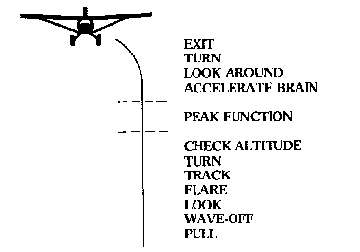
Roger Hull
Oh come with me and we'll go up there
Where the wind blows cold and
there ain't much air,
Where the clouds are ice and your blood runs thin ...
But don't worry, toad, we're comin' down ag'in.
Like a frog, a
screamin' Godfrog!
When the airplane gets so high she won't go no more
With a laugh and a
holler it's out the door!
Down amongst them clouds to play
Like that ol'
eagle who does nothin' else all day.
Then back on the ground when the Whuffo's ask "how come?"
And
you really don't know,
And you are feelin' sorta dumb...
Well, you may wonder but I know why -
You're a screamin' Godfrog and you
love the sky.
C.G. Godfrog (Pat Works)
Walk and chew gum ... aviate, navigate and communicate ... do more than one thing at a time and you are developing and using increased awareness to get more accomplished for the time invested. You do that now in relative work; you have to time-share your attention with other flyers, your body position and the ground.
But there can be much more. For the same investment of time and money and with your usual number of jumpers, your skydives can be planned to place greater demands on your attention and awareness ... to produce greater rewards. Doing two or more sets of formations at the same time is a good way to start.
Most of us started doing relative work as if we were looking through a tunnel, staring at whatever was straight ahead with little or no peripheral awareness. For instance, it is fairly easy to "sneak up" on a student relative worker from the side, tap him on the shoulder and watch him react with surprise. Later on, our awareness expanded to the sides. We saw left and right and generally did acceptable RW as long as no one flew over or under us - they were usually unseen until after the collision.
Vertical transitions and three-dimensional maneuvering are interesting and often appropriate or efficient - and they also condition us to look up and down. If we have learned to scan the space around us vertically as well as horizontally, then awareness has been expanded into another entire dimension. Result: better skydiving.
There are a lot of skydives that can be done not only because they are interesting or fun, but because they gently force us to do more, to see more and to become more aware. Sequential RW was a quantum leap in that direction. Instead of bigger or more complex statics (which still have their place), a whole new open-ended form of free-falling expression was upon us. It extended our extra-sensory perceptors.
During the exploration and development of sequential RW we are finding that along with the complexity, even more time has to be spent on the basics, Long sequences turn out to be short if the initial formation consumes half the free-fall. Complex moves and transitions are nice, but funnels and bad entries can still happen if poor basic techniques are used. Techniques have to be almost second nature if our attention must be directed to remembering a long or complex sequence.
Timing and flow awareness must also be an integral part of the planning and the execution of a good skydive. We have to think about, plan and practice awareness from the first dirt dive just like we have to think about, plan and practice the exit, the moves and the communications.
Although we may see or be aware of much of what is going on around us on a dive, our attention is typically directed to only one spot: the leader (base) for a formation or a reference point around which the formation is being made or the person we are to dock on or fly no-contact with. Having to pay attention to or concentrate on two or more points or activities at the same time (by making it necessary to accomplish the dive) is a means of promoting expanded awareness and can result in a much more challenging dive. And with the challenge comes reward.
The dives that follow are based on these ideas and have no doubt made better, more aware skydivers out of those of us who have done them. They are some of the ones that have been done at Pope Valley and are included to illustrate the ideas and to serve as examples of what can be done.
As a start, take an even number of people, split them in half and design a sequence for the number in each half. Alternate the people in the exit, build the formations side-by-side and execute the sequences at the same time ... simultaneously, if you will. Each transition should be initiated just as the slower of the two groups completes the previous formation, with the formations being mirror images of each other.
The objective is not speed, it is not a race between the two groups. Try to keep the two formations level with each other and only about ten to fifteen feet apart. Avoid letting them collide, overlap, drift apart, develop vertical separation or get off heading. To do that successfully, you will need to concentrate on the transitions within your own formation and the position and progress of the other. It may require looking over your shoulder or across other people who are closer to you. While making transitions it will take good "situation flying" to correct for a position error between the formations while keeping your own formation level and intact.
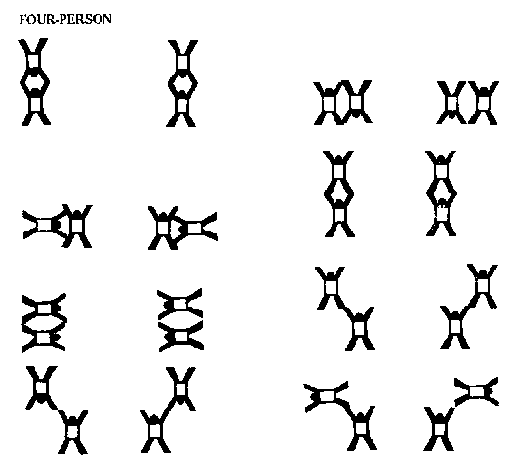
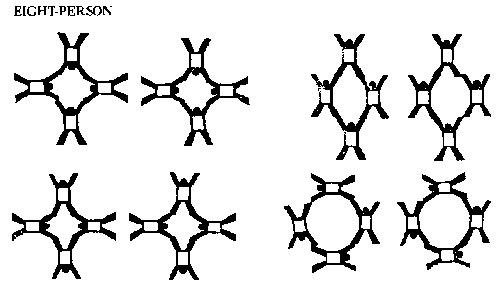
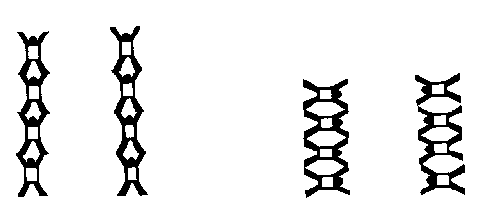
Now to add to the complexity and the enjoyment. Do a similar dive, but as each transition is made have one person from each formation swap places with his partner in the other formation. A different pair swaps at each transition so that if the number of transitions equals the number of people in each formation, the original groups are together again at the end, but on the opposite "side."
We call the dive "Transmutation." It is designed for eight people but something similar to it could be designed for any even number. To do it, set up the two leads facing the direction of flight and have the two floaters dock on the outsides of both formations (facing each other). The first pair of flyers dock on the insides; then the last pair flies straight into the open slots to close off the stars.
Plan to make all the transitions without overt signals. If everyone looks around, they'll know when it is time to move and signals will be unnecessary. Shaking usually does more harm than good anyway. Once completed, the formations need be held no longer than a heartbeat.
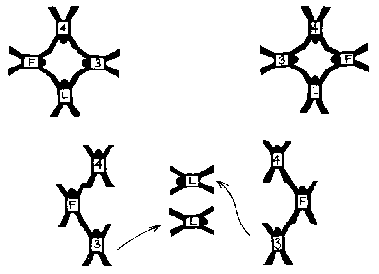
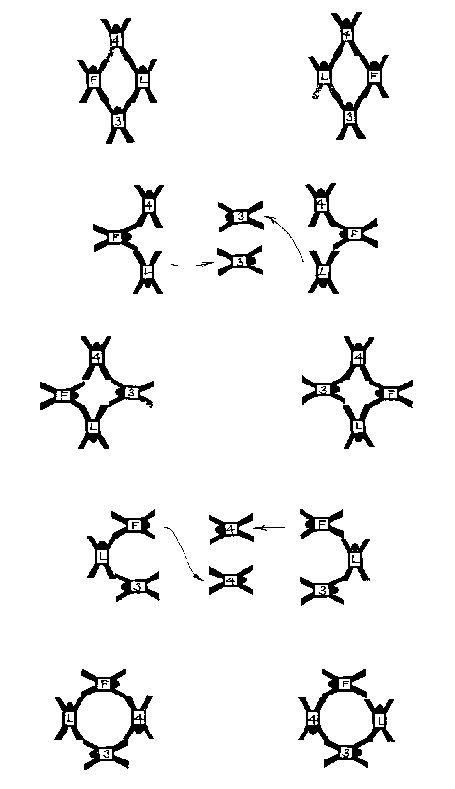
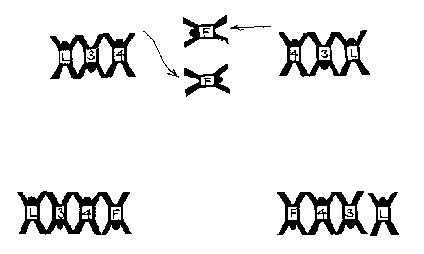
Expanding on what can be learned from the dives described so far, we get into more simultaneous sequential, but with formations that vary in size while transitioning.
"Metamorphosis" starts with eight people in the feeder formation. At each transition one person flies to the receiver formation so that one diminishes while the other expands. A transition should not be made until the preceeding flyer has docked on the receiver formation, so that only one person is moving at a time. Here it is even more critical that the formations be kept level, close together and on heading.
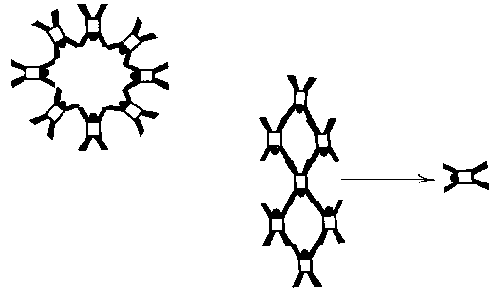
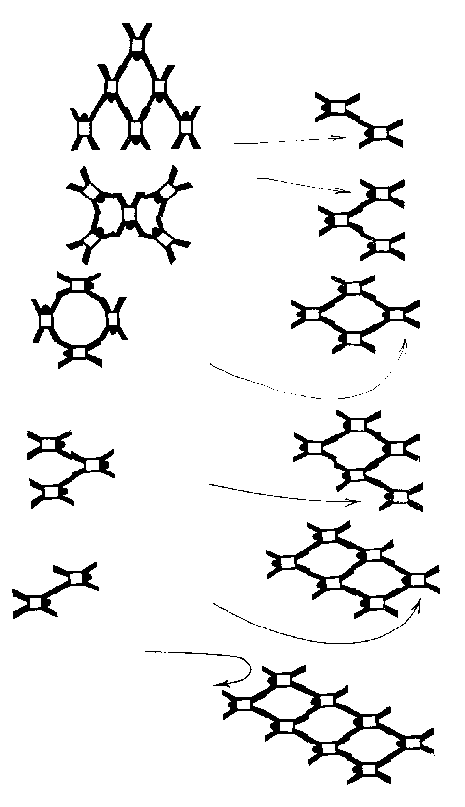
Speed will help get more done but the real objectives are smoother, more precise flying and timing and increased awareness, not merely larger numbers of completed formations. As a variation for six people, move all the receiver formations down two spaces and start with a six-wedge or six-star.
To make things even more interesting. up the ante to three formations and have them all change to a different shape at each transition. More to look at ... more to be aware of.
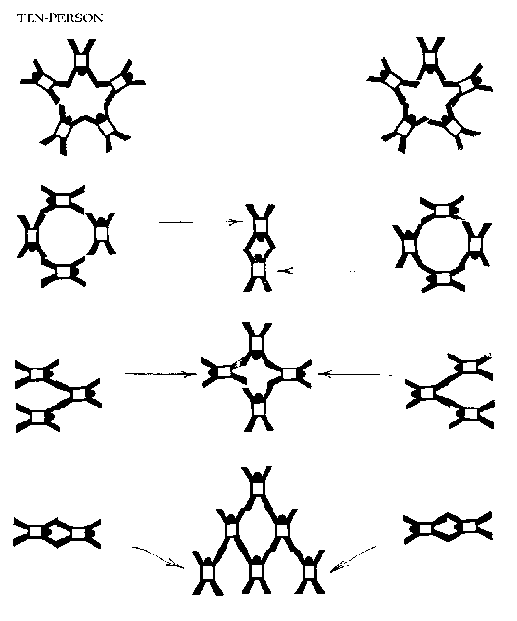
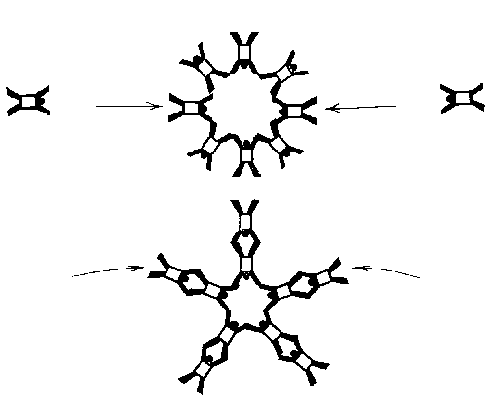
EIGHT-PERSON
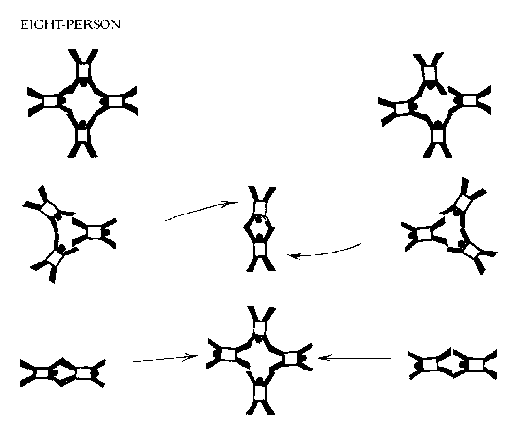
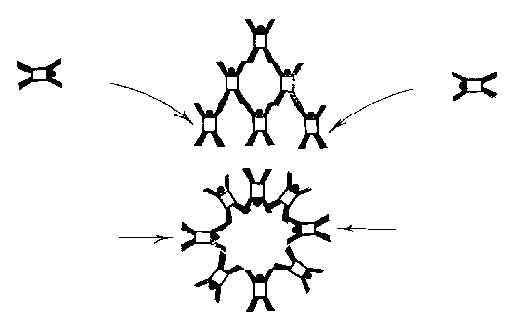
On all these dives, and any sequential dives for that matter, try to conceive of the transitions as taking place within a transparent cylinder, then fly to make the diameter of the cylinder as small as possible. Backing away from a formation - outside the cylinder - then flying back in from several meters away after your slot is ready has to take time ... time that could be used to get more accomplished later in the skydive.
Your relative position during a transition, while you are waiting, should be treated, practiced and flown as precisely as your position when you are occupying a slot in a completed formation. Allow only enough room for the planned movements of the other people near you, keep your head on a swivel, and never let your slot wait empty when it is ready for you. Be there.
Here is a skydive that can help you practice that concept. You may be surprised to find that the sequence will go faster with the five people than it would if there were only four, if the person on the perch at each transition is close and ready to take the slot. It's called "Isotosis."
A different person sits out each time so that everyone "misses" one formation. Unless you are a completion freak, repeat the cycle by backing one person out of the five-star, leaving the original set-up, and keep moving. Besides being intense and enjoyable, it is a great way to use a team alternate, if you are into that.
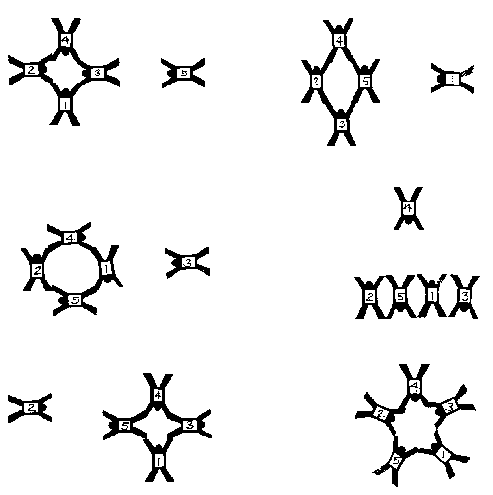
When you have practiced these dives, understand the objectives of their design and have begun to plan a few of your own, avoid treating them as isolated techniques. Integrate the multiple-formation concept with other sequential styles to develop more appealing skydives. Mix in some piece flying or vertical transitions so that your dives are well-rounded. Don't bog down on any one technique or style at the expense of others you find enjoyable, unless you want to.
Try this mixed-technique dive: The two four-stars open to lines, one flies over the other, then they both turn 180[[ordmasculine]], level and dock into a single star. The eight-star breaks on the opposite axis, each line transitions to a bi-pole and the bi-poles dock on each other. With only two grip switches, that opens out into an eight in-out. Put some canopy relative work on the bottom end and you will be out of breath when you get to the ground. More intensity ... for not a penny more.
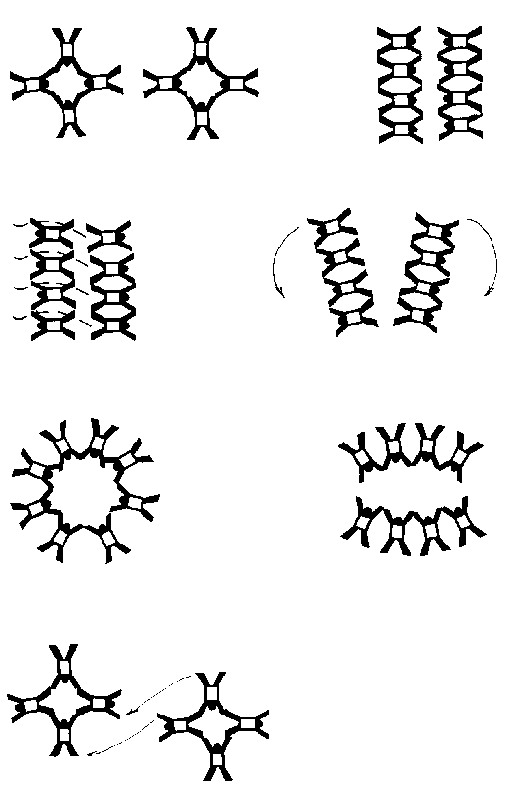

Awareness ... it's part of what this skydiving trip is all about. From the first jump right up through the most recent one we are able to sense a little more of ourselves, others around us, what our bodies are doing, the ground, relative positions and speeds and the relative wind. If your jumping stagnates - if you find yourself doing the same skydives or making the same mistakes - it may be because your awareness has stopped expanding. It is often hard to tell which comes first.
If you are more aware, you can do more. And trying to do more helps with the awareness.
-Roger Hull, Parachutist, January 1978
I jump out of airplanes because I like freefall, It's an ultimate experience that satisfies some deep existing need within me. Freefall is a release, a state of clarity, a metamorphosis into Icarus. I fly with wings I have won for myself.
For me, the most fully satisfying skydive is sequential maneuvers. A good sequential maneuver fulfills the need to do good relative work. It fills the freefall with the intense beauty of doing that which I love - it's full-on 500,000 watt ecstasy.
Flying is motion, and motion is poetry. There is a special purity and unrestricted beauty about freefall flying. And in a way that is uniquely personal, this purity and beauty directly reflect your ability. Your body, mind and imagination all work together to synergize into the most perfect flying machine you can be. You become a symphony unto yourself, if you will.
Although perfection itself doesn't have limits, the expression of perfection through flying must be limited by time and space. Thus for each body, every freefall maneuver has a theoretical limit. If you fly too fast or if you fly too slow, you get further from your goal of perfection. But when you fly at perfection, you are unlimited. When you fly at perfection, you are There.
New SCR holder Richard Bach said the same thing in one of his famous books. The Elder advises Jonathan Livingston Seagull: "Heaven is being perfect ... you will begin to touch heaven, Jonathan, in the moment that you touch perfect speed. And that isn't flying a thousand miles an hour, or a million, or flying at the speed of light. Because any number is a limit, and perfection doesn't have limits. Perfect speed, my son, is being there."
In sequential maneuvers the most important thing is to be where you are supposed to be at the right moment with a clean, fingertip docking. Being good at it comes from everyone in the group doing RW together. You learn these things by practice.
Ground practice and sketches of each maneuver are absolute musts for RW maneuver flying. If you are unfamiliar with grip switching, flying backwards and no momentum relative work, then practice in four-man RW is where to start.
Four-man practice teaches you how to fly from one maneuver to the next without going low or being sloppy. GOING LOW IS THE MOST COMMON MISTAKE IN SEQUENTIAL MANEUVERS. Four-man RW also teaches you control and precision. Precision is critical because you must dock at your assigned position so as to have no effect on the building formation's stability. Good no momentum RW requires full control of your entire body.
Learn how to gain a bit of altitude while you hand-track. You will very likely need it as the next maneuver builds.
Never expect a maneuver to absorb any excess speed you have. Be precise. Be perfect. Put your body where it is supposed to be. Make a no-wrinkle docking and get a firm grip on your contact man's jumpsuit.
For building a maneuver, and in sequencing from one maneuver to another, your flying is mostly of the no momentum type, You fly instead of coasting. You feel a lot like an eagle whether you're closing the tail of a diamond, or lining up backward as the point-man.
As you approach a maneuver in freefall, the electricity starts when you spot your contact man and swing toward your position. Use every part of your body to fly toward that invisible, intuitive spot. You may be flying sideways, even backward.
If you're entering after the "base" in the second maneuver, grab extra altitude and be headed for your docking point before it happens. On contact, be absolutely sure your entry will assist the entry of another flyer in the maneuver.
If you and your friends decide to get together with a serious maneuver team, you'll need a few ground rules, just as you would with a competition 10-man or 4-man team:
Your first several jumps together may be disheartening. It will seem impossible. But keep at it; try to think of new ways to make things work better. Soon it will begin to click.
On-the-ground planning sessions are vital to maneuver RW. Every team member should be provided with sketches of the maneuvers and each man's position. Everyone should think about them and contribute their ideas on the best way to do them. These ideas all add up to a game plan. The game plan need not be written, but it should show each man's position and how he should get there. A master team logbook would be a definite advantage as well.
After the plan for each jump is developed, talk it over. Discuss each detail. Try to think in terms of the best team and the best maneuver instead of the best "you."
Ground practice is absolutely essential to making the maneuvers happen in the air. Use it to learn to work together and coordinate your movements on the ground so that every maneuver becomes practically second nature. It may be compared to football or any other team sport practice where coordinated interaction with one's teammates is required.
Slowly walk through the entire maneuver(s) on the ground at least four times before every jump. Build each maneuver just as you will in the air, starting from exit. Imagine that you're in freefall. Don't build a maneuver in 10 seconds if it usually takes 35 seconds in freefalI. Walk into the next maneuver in sequence and in proper timing, Then imagine break-off time and pull sequence.
Spend a lot of ground practice time learning the mechanical steps of building each maneuver so you won't have to waste a lot of time in the air learning them. With good ground practice, you'll learn the cadence of each jump so that you'll all feel every maneuver together, and they'll fall together beautifully in the air.
Good sequential relative work is, in part, a matter of mental approach, It's your attitude, or in other words. the programming of your mind's eye to achieve the best flying results.
To learn to fly RW maneuvers well and with perfection, you must do a lot of relative work, learn to relax, and be able to fly with your imagination. Then truly you will be riding on wings of wind.

"We dance to a whispered voice, overheard by the soul, undertook by the heart, and you may know it if you may know it." -Neil Diamond
-Pat Works, Spotter, May-June 1975
RWu spotted the following words on the wall of the hangar at Columbine Parachute Center at Casa Grande, Arizona, and would like to share them with you. They are attributed to Terry Cooper, SCR-486.
"When we know for sure that we all fall through the same air, then big stars will fill the skies ... Psych yourself - or someone else will and they may be thinking negative. Refusing to let a person on a load is like burning his canopy... you might as well torch it, he has no use for iton the ground. If you think someone is not worthy of being on your load, throw him off - but remember this: nine people make a lousy 10-man star."
RWu. June 1974
In case you missed it, we think the following excerpt from Norman Heaton's March Parachutist editorial bears repeating:
"... It makes no difference what is one's `bag' in this game: we all do exactly the same thing: jump out of airplanes. This is the root, the very basis of any amount of camaraderie inherent in this sport of parachuting. Any attempt to belie this is an attempt to destroy the common good of all. No one can justifiably degrade or isolate someone else because their thing in parachuting doesn't happen to be your thing. And vice versa. We all put our rigs on one strap at a time."
RWu, June, 1974
Between the insecurity of childhood and the insecurity of second childhood, we find the Skydiver.
Skydivers are found everywhere: in bars, under bars, behind bars, looking through bars, in trouble, in debt, in love and in the air.
Skydivers come in assorted sizes, shapes, and weights in states of sobriety, misery and confusion.
Girls love them, mothers worry about them.
Unemployment Checks support them, and, by some coincidence, they manage to get along with each other. The skydiver is laziness with a deck of cards, a millionaire without a cent, bravery with a smile.
The Skydiver is a composite sly as a fox, has the brains of an idiot, the energy of a turtle, the sincerity of a liar, the appetite of an elephant, the aspirations of a Cassanova, the stories of a hero. When he wants something, it is usually free jumps, more money, a good piece of tail. He dislikes ASO'S, getting up early. small planes, hot-shot pilots (who never hit the DZ), the week before his payday, his girls' father's curfew, and legs (that is a landlover). He likes girls, women, females and all members of the opposite sex.
No one can think of you so often and write so seldom.
No one can get so much fun out of your letters, old jump)suits and sex movies.
The skydiver is a magical creature: you can lock him out of your house, but not out of your heart.
You can take him off your mailing list, but not out of your mind.
-Author Unknown
How to Lose at Tennis (Or Anything) Without Really Trying - And What to do About it.
Introduction: The nation's pioneer expert in the field of sports psychology and author of the new book, Sports Psyching: How to Play Your Best Game Al1 of the Time (published by J.P. Tarcher, Los Angeles) explains why sports has us talking to ourselves and tells what those inner voices mean.
IF YOU started carrying on a conversation with yourself on an airplane, in a restaurant. or standing on a sidewalk, people would probably give you wide berth.
Not so, however, if you do same on a tennis court or golf course or other sporting arena. No one seems to think there's anything particularly strange about a tennis player saying to himself, "Not that way dummy!"; or a golfer blurting out, "Come on, now, follow through, keep that head down," as he steps up to the tee; or a pitcher saying to himself, "Steady, steady;" or a grown man having a tantrum at the 10 yard line after missing a long pass. We often see famous athletes talking to themselves and, when we play, find ourselves doing it too.
What would otherwise be classified as irrational behavior seems to be socially acceptable in sports. This does score a few points for the R.D. Laing set who see sanity-insanity as social definitions anyway. But. mainly, it says something about athletic games themselves. In them. we not only talk to ourselves, we hear voices. Not that we hallucinate actual spoken words; it usually takes the form of those little ideas whispered into our consciousness as we play. You are lining up a particularly tricky and dangerous downhill putt and the voice says "go for it." You lose caution, putt too hard, and roll the ball six feet past the cup. The opposite happens just as often. You've got an 18-inch putt and suddenly the idea pops into your head that this is The Big One. You then feel like the abominable snowman has embraced you. A condition known to golfers immemorial sets in. Bobby Jones used to call it the "yips," You freeze and the ball rolls to a sickening stop six inches short of its destination.
Carryovers From Childhood Often Defeat Us As Adults. Although these are all common experiences, most of the time we overlook them when trying to figure out why we did well or poorly in a game. The context for describing sports action is largely in terms of the physical. We tend to talk as if sports were little more than an elaborate set of calesthenics. The serve was out because you tossed the ball too high: you guttered the bowling ball because you rolled your wrist: you missed the putt because you didn't follow through. You want to improve your game and keep from repeating those mistakes and, following this conventional logic, you look to physical solutions for what you think of as purely physical problems. You read the instruction book, study the diagrams. watch your favorite pro on TV. Then you go back and make the same mistakes again.
This is because most of the time the root cause of the fluffed shot is anemotional reaction. The immediate cause may be something physical. But it was an emotion that set it off. You wanted to make the play or felt you had to make the play and as a result, in your anxiety, you either muscled it - exaggerating some motion - or you froze up. We've all had this happen to us. But few wish to explain or deal with it on psychological grounds. This is because, again, the conventional explanation paints you into a corner. If someone reacts to pressure, the verdict usually is that he "choked," or is "a flake." So a lot of people ignore their reactions to pressures in a game. They say they don't feel any pressure,, that they are only playing for fun. Or they use a superstitious explanation. They were "jinxed" on this play, or they should have worn their lucky green socks.
All of this sidesteps a very real component in the nature of all sports. All athletic games are emotional experiences. The feelings are the very reason we all play. All sports involve challenge - you try to sink the basket, get the strike, can the putt, and so on - and that leads to some amount of anxiety in anticipating whether or not you'll make the play, win the game. Pressure is part of every game and every player - no matter how cool he may pretend to be - feels it.
We attach great importance to the outcome of sporting contests. We are encouraged to do this all the time by pervasive social influences. You can't help but be tempted to measure yourself when you go out - for a game of tennis or golf, (or to do RW). no matter how friendly. And to some extent, this is part of the fun, a little game you play against yourself to make things interesting. Part of you becomes a spectator in each game you play. rooting from the bleachers.
The trouble starts when the spectator comes down out of the stands and onto the field - throwing beer cans, when the "spectator" in any way begins to distract the player. We talk about how tough it must be for professional players to perform in front of huge crowds. But lots of recreational athletes create their own imaginary crowd of jeering, hooting, cheering fans - this being made up of their own inner expectations and anxieties.
In sports, as in life, what you want isn't always what you need. You are playing Jack, your old buddy, and this is match point and you want to win it. But what you need to accomplish this has nothing to do with whether or not it is match point or how many games you've won or Jack has won. What you need is to be relaxed enough to be limber, fluid and flexible on the court and to be concentrating on the ball and not on your thoughts about the score or anything else - not on the goal you want. The ball, the net, your racquet, the court are all the same whether it's match point or just for practice. You have to make the same moves to complete a successful shot whether it is only a warm-up or a hot rally for the big prize.
In other words, the things you need to do as player have to be smooth, cool, focused on the action, while as a "spectator" you are putting on all the pressure for the things that you want.
One of the trickiest things to learn in sports is separating those two modes of behavior. All the traditional rah-rah, "up for the game" stuff we hear is misleading. Certainly, players need to be motivated to put in the kind of time and effort needed to perform at high levels. But usually it is the exaggeration of the importance of the desire to win that caused the problems. The pressure becomes so predominant that it takes a player's attention away from the game. Performance suffers rather than improves.
Great athletes are those who can stand the pressure, as we all know, but they don't do this by necessarily piling it on themselves. Instead, they have found ways to shut out those pressures when it comes time to play and to channel the energy into their performance. Veteran pro players commonly talk about concentrating so much that they are not even aware of the thousands of people in the stands. Likewise, their own inner thoughts are less of the spectator variety ("Come on, now, do it!") and more of the calculating "player" variety ("I notice a weakness on the right side: next play I'll go in that direction").
A good first step in getting a handle on pressure is to start listening to yourself. Become aware of the kinds of things you say to yourself in a game (or on a jump).
Do this non-judgmentally, by the way, or you will be defeating the whole purpose of doing it in the first place. Monitor yourself during your next few games, casually, without trying to change anything just yet. Separate the "spectator" type things you say - or think to yourself - from the "player" type strategy thoughts. The frequency and the force of the "spectator" type things you say or think to yourself almost certainly will correlate with how nervous you become in a game and how much your performance suffers from exaggerated, self-induced pressures. The more you yell at yourself - like some desperate coach - the worse it is. But just realizing what is happening - that this isn't something real, but a habit we internalize from outside influence - will help to get it under control. For example you could be saying to yourself, "Damn it, get the hell in there. Why can't you get it right?" over and over while your performance gets worse and worse without realizing that it is precisely your own "spectator" exhortations that are getting in your way. To understand how this mental habit is operating is to help put it back into perspective, so that you can concentrate on the game.
In addition, the kinds of things you say to yourself are an important indication of the way you feel about yourself in relation to sports. Emotions can become a problem in sports in a variety of ways, depending on individual reaction. Some people, for example, tend to be too aggressive, so much so that they become ruled by anger in a game, often becoming vulnerable to being provoked into unwise moves by cooler opponents. On the other hand, some suppress the normal amount of aggressiveness needed in most games and tend to be too easily intimidated. You might lack confidence, or have too much of it. You might be too easily discouraged into an "I don't care" attitude, or be so driven that you are a perfectionist who is constantly tied in knots because you never seem able to reach some impossible goal.
Some of the typical things players say to themselves tie in with long standing attitudes and characteristic ways a person has learned to react in any game. If these reactions are continually a problem, the best way to start getting at them is to listen as they manifest themselves in terms of those inner voices. In this way they will soon become understood and predictable and lose some of their hypnotic potency.
The More You Yell At Yourself - Like Some Desperate Coach -The Worse It Is. Some of the typical "spectator" statements are: "You'll never get it right ... That was a good shot, but it could have been better..." and the like, which indicate that chances are the speaker is overly driven.
"I'll show them ... I'm going to ram this shot down his throat ... Now I'mreally mad..." and the like usually are connected with over-aggressiveness.
"I'm uncoordinated... I'm just a klutz, I guess... I'll never do it ... Wow, that was a great play, you're terrific... What's the use... Looks like I'm sunk..." and such are tied in with lack of confidence, tendencies to be too easily intimidated, feelings of inadequacy which discourage players from practicing or taking lessons to improve performance.
"You dummy... You can't do anything ... You're no good."... and so on, which are often tied into the compulsion to feel guilty every time one misses a play or loses a point (or zaps a formation.)
If you mull over some of the things you say to yourself in a game, you'll find they will lead you back to the ways in which you were conditioned to feel about sports as you grew up. You probably fell into certain patterns as you played in the school yard and now you carry them with you onto the tennis courts and golf courses (or your playground in the sky) even though now they no longer make sense. This doesn't mean you have to psychoanalyze yourself in order to play better. We can safely say that, for the most part, the way all of us are conditioned to react in athletic games during our school years is a disaster wherefrom the superior players are survivors who have gone on in spite of the system rather than because of it. The rest are left with some degree or another of negative attitudes which interfere with our playing to our best potential, whatever that may be. The school gym and athletic programs are little more than a continual calling out process for the more talented kids who, step-by-step, participate in higher and higher levels of competition, from Pony Leagues to high schools to college and finally to pros, as all along more of us are being relegated to the status of spectators. At one level or another someone always loses and, what's worse, is made to feel that there is something shameful in this. Kids are thrown into complicated, competitive games usually before they have learned the simpler kinds of exercises that let them develop subtle motor skills needed for sports, and, just as importantly, confidence in their abilities. We are set up for Walter Mitty daydreams about sports superstardom without the wherewithal to even attain fundamental skills with any consistency. The results are disappointment, frustration, anger, guilt. It's the reason Charlie Brown is such a compelling character. There's a little of him in all of us.
What was learned, however. can be unlearned. You don't need to drain sports of their emotions. On the contrary, you can clear away lots of societally-inspired emotional baggage that gets in the way of being able to feel the real joys of sports, the exuberance that comes when you make a play that is your best, that is better than you thought you could do. If you keep that spectator part of you in the stands and behaving himself as an encouraging, supportive fan rather than an agent provocateur, you'll have made the initial big move toward that happier situation. It isn't always easy. Old habits are hard to change. But if you keep practicing the new ones of being more aware of yourself, they gradually will replace the old ones with more and more regularity.
Being aware of the psychological dimensions of what is happening on the playing field also can make all games much more interesting and rewarding. It is essential to what is colloquially known as "playing your own game." You can't play your own game until you start to know it up close.
Thomas A. Tutko. Ph.D. and Umberto Tosi. Golden West Airlines Magazine. July 1976
Oh, I have slipped the surly bonds of Earth,
And danced the skies on
laughter-silvered wings:
Sunward I've climbed and joined the tumbling mirth
Of
sun-split clouds - and done a hundred things
You have not dreamed of -
wheeled and soared and swung
High in the sunlit silence. Hov'ring there,
I've
chased the shouting wind along and flung
My eager craft through footless
halls of air.
Up, up the long delirious, burning blue
I've topped the
wind-swept heights with easy grace,
Where never lark, or even eagle flew,
And
while with silent lifting mind I've trod
The high untrespassed sanctity of
Space,
Put out my hand, and touched the face of God.
John Gillespie Magee
Have you ever noticed that during an inspired jump, time expands so greatly that the recounting of the jump takes longer than the jump itself? Instants become moments sung by the heart and remembered with ecstasy.
When we become totally immersed in a sport of creative action like relative work, we lose sense of time and the external world. Instead, we experience joy, the ecstatic feeling that everything is going just right. For me, this is the highest form of enjoyment, and I call it "the joy to be had in joy."
This feeling is expressed as "flow" by other individuals who experience it. Flow, as psychologist Mihaly Csikszentmihalyi of the University of Chicago describes it, develops when we are completely immersed in what we are doing. In this state, a person loses a self-conscious sense of self and time. He gains a heightened awareness of his physical involvement with the activity. The person in flow finds his concentration vastly increased and his feedback from the activity enormously enhanced. Ultimately, he enters an ecstatic state to such a point that self-awareness doesn't exist.
"How are we to know that the mind has become concentrated? Because the idea of time will vanish. The more time passes unnoticed the more concentrated we are ... All time will have the tendency to come and stand in the one present. So the definition is given, when the past and present come and stand in one, the mind is said to be concentrated." Vivekananda
Dr. C.'s studies of flow, described by individuals participating in activities that are rewarding in and of themselves, are the subject of an article by W.B. Furlong in Psychology Today, June 1976. What is said about others' involvement in their sports can be directly applied to relative work. Good relative workers radiate energy. They can fly sideways ... and backward. They become one with the air, effortlessly. The article suggests that the high joy of relative work offers its participants pleasure by its very nature.
In Furlong's article, a rock climber describes it: "You are so involved in what you are doing you aren't thinking of yourself as separate from the immediate activity." Said another rock climber, "It is not moving up but a continuous flowing. you move up only to keep the flow going. There is no possible reason for the climbing except the climbing itself. It is a self-communication."
The article goes on to relate how others define flow: People in flow undergo an intense centering of attention on the activity. They do not try to concentrate harder: the concentration comes automatically. "The game is a struggle but the concentration is like breathing - you never think of it," said an expert chess player. A dancer described it, "Your concentration is very complete. Your mind isn't wandering. you are not thinking of something else, you are totally involved in what you are doing. Your body feels good. Your body is awake all over. Your energy is flowing very smoothly. You feel relaxed, comfortable and energetic."
In flow there is a sense of being lost in the action. The individual experiences an altered sense of time. "Time passes a hundred times faster. In this sense it resembles the dream state," said a chess player. Sometimes the centering of attention produces a spatial alteration akin to the changed sense of time. Baseball players in a hitting streak often say they see and hit the ball so much better because it seems much larger than normal as itcomes up to the plate. Ted Williams said he could sometimes see the seams turning on a ball that was approaching him at 90 miles per hour. In his prime, Arnold Palmer could look down at a putt and see a line on the green that led from the ball to the cup.
Thought Destroys Flow. There is no sense of the self in the period of flow, says Dr. C., but there is what he calls a "merging of action and awareness." Take a reader absorbed in a book. He is turning the pages and he knows he is turning the pages, because that is the only way his reading can go on. But he does not notice that he is turning the pages.
Flow is a floating action in which the individual is aware of his actions but not aware of his awareness. A tennis player who is intensely aware of the ball, and of hitting it, does not reflect on the act of awareness itself. He is not bothered by such thoughts as "Am I doing well?" or "Did everyone see that shot?" These thoughts destroy flow. If the moment is split so that the player perceives his action from the outside, then flow halts.
Another factor in flow is the clarity of response that the individual gets from the activity. The feedback in sports is a good example; the tennis player knows instantly whether his shot is a good one, as does the basketball player, the marksman, the billiards player. It is a trifle more subtle in the creative arts. The performer may get immediate responses from his audience, but the non-performing artist - the composer, sculptor, painter, writer - must get it from an internal sense of rightness.
The feedback is not an end in itself, but rather a signal that things are going well. The person in flow does not stop to evaluate the feedback. "The action and reaction have become so well-practiced as to be automatic," says Dr. C. "The person is too concerned with the experience to reflect upon it." A teenage basketball player put it, "I go out on the court and I can tell if I'm shooting OK or not. But if I'm having a super game, I can't tell until after the game."
Flow can make a person feel an almost Godlike sense of control. All the dichotomies, polarities and conflicts of life are resolved. A basketball player explains, "I feel in control. Sure, I've practiced and have a good feeling for the shots I can make. I don't feel in control of the other player, even if he's bad and I know where to beat him. It's me and not him that I'm working on." Said another, "Although I am not aware of specific things, I have a general feeling of well-being, and that I am in complete control of my world."
To induce flow, an activity must allow each individual to meet a challenge at the outer limits of his capability without testing him beyond those limits. Once he goes well beyond his limits, he begins worrying about the severity of the test and about himself - his safety, or his success. These worries break flow.
To flow, an activity must offer fast and direct feedback. For this reason it should be very simple and have clear, noncontradictory rules. It should lack the ambiguities of real life. The participant sees clearly what is "good" and what is "bad" and how to seek the good. One stamp of flow activities is that they do not demand incompatible things. Games and sports are good examples. The ball is in the air; we can catch it or not. So we focus on the ball and on catching it.
While a surprisingly diverse number of activities have the potential of producing flow, not all activities will yield a deep flow experience. And not everybody can get the sense of ecstasy associated with the most intense moments of flow. Whether flow happens at all, and if so, how deep the experience is, depends not only on the activity but on the individual's attitude toward it. Some people cannot surrender completely enough to the moment to allow flow.
A person who feels severely over-matched in a competitive activity will be blocked from flow. For example, if a weekend tennis player is matched against Jimmy Connors, he is likely to be overly concerned about how he's doing, and so become too tense for flow.
"Thought is time and Time creates fear."
* * *
Ask yourself: What time is it?
Answer: Now.
Answer the question
until you can hear it.
And, on jump run, or wherever, focus your thoughts in
the present.
Don't Think About the Future.
Just Be Here Now.
Don't Think About the Past.
Just Be Here Now.
Then, reflect on the thought that if you are truly Here and Now -
- It is enough, and
- You will have optimum power and understanding to do the best thing at the given moment. Thus, when "then" (the coming jump) becomes Now - if you have learned this discipline - you will be in an ideal position to do the best thing, and need not spend your time now worrying about "then."
Adapted from Be Here Now, Baba Ram Dass, P. 90.
By Pat Works
Partially reproduced from Psychology Today,
June 1976,
"The Fun in Fun "
by W. B. Furlong
To Whom It May Concern. There was a time when the time did not matter, but now there has come a time when time matters, and it is time to think about time. And it's about time that we think about time because up until this time we have really not taken the time seriously. So, seriously, the question is, what is the matter with the time this time? I got seven hours sleep, and still stumble but that has nothing to do with time but merely body chemistry. Which has something to do with subjective reasons (I guess) objective time, but I don't think that's really what we're talking about. I think what we are talking about is time, and time passes by and we all get older and a little wiser (very little), but most certainly old, and does anybody really know what time it is?
Weird Al (Warsh), RWu, June 1976
A Formula for Flow
But a match of skills and challenge does not guarantee flow. The other prerequisites are internal.
The domain of flow is the band between anxiety and boredom. An alert mind resists boredom by keeping us involved in events around us. A relaxed body is the physiological opposite of tension. The two together - alert mind, relaxed body - combine to make us ripe for flow.
Psychology Today, June 1976.
What could I write about relativework
What could I?
What could I
write about the way of the wind
and working it with you
to go
and
flow.
You can ride the wind
always
but it always wins
always
always
sings its own song,
Ride
upon wings of wind?
sure
but first sing its song
go along
ride
where it takes you
and smiling
direct its flow
to ebb and coincide
with your brothers and sisters
as they dance and flow with their own wind
song.
come listen
come sing
come ride with us the wind
and let
it tell you its story
in voices of sunset
in valleys of light
in
chasms of clouds towering
to lend foundation to the words
that the
winds sing
Joy! sing joy!
in voices deeper than all our understanding.
what
could I write about relativework when you need only ask the wind?
Pat Works
Freefall Physics and the Relative Worker
Total energy...maneuvering potential ... energy maneuverability ... words borrowed from those who design and fly airplanes. Terms which have direct applicability to jumpers and relative work ... concepts which are probably more widely understood and used than expressed. Without fear of trying to over-simplify or to quantify at all what we are doing, we can explore the realm of potential by looking at subjectively definable boundaries expressed as velocities.
How fast and in what directions can we go and how can we use those velocities to our advantage?
All of the physical energy we use (or have available) in relative work is Newtonian - it comes from the act of descending under the force of gravity. "Gravity is a geometrical phenomenon" - pause for reflection - "and we are doing geometrical things with potentially definable velocities."
Our total energy control on one dive, on one day, is the n-dimensional sum of the jumpsuit, the gear and the mass of the jumper. The amount of energy that is, or can be, used constructively in relative work depends on several things. The most important one is the "thing" we are trying to do relative work with. Be it a person, a grapefruit or a frisbee figbar f lake minus one (you!), it is falling at a speed at any one moment. Allow me to refer to that speed as the reference rate of fall.
Then there is judgment. Judgment, developed and tempered by experience and forethought, allows us to exercise the limits of our potential without exceeding them or the restrictions imposed by the nature of the dive.
Another and perhaps more directly influential factor is state of mind -our willingness to fly at or near the edge of our "known" potential capabilities.
We do not develop energy as an airplane does with its engine, but we can and do convert it, redirect it, channel it and use it to accomplish our purpose: being in one place in the sky with respect to a moving reference and staying there. It is that moving reference that prevents our easily defining such things as potential energy which, in the usual sense, depends only upon vertical separation from a fixed reference.
The one phenomenon which keeps us from accelerating constantly to some hypersonic velocity in a mere two mile fall is lift. At a rate of descent we refer to as "terminal velocity", that lift is sufficient to counteract the force due to gravity and we no longer accelerate, all other things being equal. It is by changing those things which were assumed to remain equal that we can do relative work. We can block the air (projected frontal area), redirect it (deflection and friction) or compress it and expand it (aerodynamic lift). Drag and friction allow us to change our rate of descent from some loosely defined "normal" by changing body size or projected frontal area (the number of fractional acres your shadow covers on the ground), Deflection is the means by which we sideslide and delta and backslide. Aerodynamic lift is the essence of the maximum track - forming ourselves into a wing with airfoil shape.
In freefall, there is for each of us a maneuvering envelope that is independent of anyone else in the air. Each of us has an absolute (for now) fastest and slowest descent rate. There are other boundaries to this conceptual space but allow me to harp on the vertical ones for a moment.
Reverse arch ... maximum recovery ... de-arch ... whatever you call what you do when all your friends are looking down on you is a position most of us are all too familiar with. It is a fact that if you are moving in any direction other than straight down with respect to the air, you can not be falling as slow as possible. You may be falling as slow as you know how, but not as slow as possible. To explain: acceleration results only from a force.
In order to move laterally, something has to push you. That something is the result of air that has been deflected laterally to some extent. Only so much drag and friction can be generated by one person at one time when it is "all hung out". Consider it a quantity of force. Any fraction whatsoever of that quantity that is used to move laterally in any direction must, by the Law of the Apple, be subtracted from what is making us fall slower, or would have made us fall slower. If you are moving forward slowly in a reverse arch, you ain't optimizing. (Try putting you toes together with your knees spread).
But I digress ... try to accept the fact that there is an upper limit today. In the opposite direction, there is similarly a maximum return to the firmament speed. And, here again, if you are moving forward at any speed at all, you aren't going down as fast as you could (maybe just as fast as you know how). If you could go forward and maintain maximum vertical speed, then a sailboat could run directly into the wind without tacking,
We were talking about an envelope, and now we have the upper and lower boundaries. On the front end (forward speed) is your max track: and then there is the back track (track backwards?) and the sideslide left and right and the do-see-do, swing your partn ...
All of these parameters are more or less proportional to the maximum and minimum surface areas we can expose and maintain into the appropriate component of the relative wind. Whether or not we can actually achieve these maximum velocities on a particular dive depends on the time available and the precision with which we can shape ourselves into our best "known" body positions.
Virtually all the positions used to operate on or near the edge of the maneuvering envelope are inherently unstable and require a high degree of concentration. Witness those who flip over trying a reverse arch or Z into front loops learning to track. The reward for operating at the edge without exceeding it can be called maximum performance. The price paid for exceeding a "limit" is loss of control and gross inefficiency. Flying in the interior, short of the edge, when maximum performance would have been appropriate results in a cost which is ordinarily manifested in terms of time - delay in reaching a point in space.
Each of us has a unique envelope. The "reference point" in any envelope is determined by an external source, like another jumper's neutral frog rate of descent. The envelope for a single jumper falling alone has no reference other than zero horizontal airspeed. The vertical zero reference would be whatever speed the jumper happened to be falling. The external source may be one jumper (the leader) or several (a formation). Each jumper's maneuvering potential is given in rough measure by the amount of envelope that lies between the reference point "in use" at the time and the edge of one's personal envelope. The time required to correct a displacement error is a function of maneuvering potential available and the willingness to operate at or near the edge of one's own ability.
In determining what sort of maneuvering is appropriate to correct a displacement error, there are rates of change in velocity - accelerations - to consider. Quite often this is where the greatest judgment is required. How long will it take to accelerate to the planned closure rate and, more importantly, how long will it take to dissipate it to zero one microsecond before "arriving"? How much slack is there in case the reference point changes its velocity in some random direction - say, toward a jumper who is attempting to correct an error in position as rapidly as possible?
The maneuvering envelope so far drawn is purely imaginative. There are no numbers to support it (yet!). But we are not as much interested in numbers as we are in subjective comparisons and evaluations of jumpers. We know that some people simply do not know how to track as fast as others. Some do not know how to backtrack at all (at least intentionally and under control), probably because they have never tried. By comparing maneuvering envelopes, we can plainly see ...
That reminds me of the bullshit phraseology used in a lot of math books: "Clearly, the triple integral... ", or "It is obvious that the solution... "while you sit there mystified and insulted. But I digress...
Let me put it this way. If the envelopes had numbers on them, we could draw them on something transparent, stack them up and look for that area that was common to all of them. That range of velocities is where we have to be to have any hope of completing something with that group of people on that dive. By comparing envelopes this way, even mentally, it may be apparent that if the reference rate of descent is established above the upper limit of a particular jumper, he will go low and stay there unless he is holding on to someone with more "room at the top". The converse may also be true for a featherweight in photographer's bells with a Protector for a main who can just get down in a dive but bobs up out of sight, even in a stable fetal position. The reference point is at the lower limit of his envelope.
We do little more now with numbers than to assign exit order and entry positions and this is no attempt to increase their use or influence. Numbers are finite and finiteness is a temporary condition. Most of us have not even begun to explore the maximum of our potential for controlling ourselves in the air. Besides, at the very best these limits "fuzzy". Like, today for some inexplicable reason we can track faster than we could yesterday but slower than we will tomorrow. True, for some people the variance is small - the limits are almost subjectively predictable. For others they may vary widely with mood or how interesting the dive is.
Reasonable familiarity with your own maneuvering potential can allow you to make value judgments on other than a purely intuitive basis about what your "best" moves might be even prior to exit for various directions and distances from where you want to be.
For instance. your maximum track may actually result in a rate of descent equal to or less than the reference, in which case it could be used for alevel lateral correction even for a moderately short distance. Knowledge that your smallest stable frog or "RW stable" is not fast enough to catch a heavy student with a T-10 and coveralls should induce you to planto dive below him and pin him on the way "up". In that case, virtually all your maneuvering potential is above the reference established by the student and you could stay above him in a backslide, sideslip or a max track. Using a dive or exiting first are your only alternatives.
Once you develop a feel for your own neutral rate of descent, you should be able to determine early in the dive where the reference rate of descent is in your envelope and to start making contingency plans, especially if the dive plan calls for multiple formations or no-contact flying or vertical transitions.
See. There is nothing new about this envelope thing. You knew about it all the time.
In the interior of the envelope lies the entire gamut of minor correction moves, hand tracking and position-maintaining maneuvers. It is the area where we spend most of our time and expend most of our effort. We have all seen the jumper who seems to have flip-flop controls. He is either flat out to get someplace or hanging it all out to stop. Perhaps "thrashing" is a better term. The smooth, reliable and consistent jumper is the one who blends one move into another, constantly aware of and responsive to the changing situation, tempering his speed and direction of movement with time and distance to go, thinking ahead about qualitative and quantitative measures of his potential. He probably has an intuitive feel for what this curve says without consciously realizing it.
The little arrows on the perimeter of the curve are like "degrees of freedom". There are none on the max track or the max back because there would be a conflict of definition. However, you can fall faster in a reverse arch just by closing your mouth. The hand track is up near the top of the envelope because I felt like putting it there. The arrows say that you can move forward faster or slower, and you can fall faster with the same forward speed. The same applies to a backslide.
Sometimes floaters have to backslide and fall slow; if you are directly over your slot and the formation is moving toward you, you might need to backslide and fall faster (or just beat feet and set up again). In the first case you are on the upper limit of your envelope and to the left of the vertical reference; in the latter you are down inside the envelope but on the same vertical line, left of "center".
And on and on. This is just a way, a different way, of trying to express more concisely an overall concept that has allowed this aspect of the sport and the people who participate in it to develop to the present state-of-the-art. Maybe just one small bit of the ultimate awareness.
Roger Hull